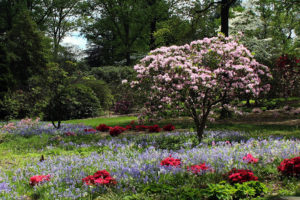We owe a great deal to the skilled horticulturist and landscape architect, Dr. John Caspar Wister, our first director. His work built on the heritage left by the Painter family as he established collections of several different genera of plants, including, of course, the Wister Rhododendron Garden.

The rhododendron collection began near the present Native Woodland Walk and North Woods. This initial collection quickly became popular during the bloom season, inspiring Wister to clear another, larger swathe of land to continue development of the collection. Planting of this new garden, now known as the Wister Rhododendron Garden, began in earnest in 1961 and continued throughout the early 1960s. Wister said, in a 1966 report, that he wished the collection to “present in an orderly way as many possible representatives of the different series, species, and hybrids of rhododendrons and azaleas to give a long season of bloom and attractive color harmony that would inspire more and better rhododendron and azalea planting in the Philadelphia area, and that it would be used by expert growers for serious study.” The collection began with the Ironclads, a group of plants selected in the early 1900s by plant collector, E.H. Wilson, for their winter hardiness. From there, the garden grew to include hybrids by many notable hybridizers of the 1900s, many of whom Wister knew well as colleagues and friends, including Guy Nearing, Charles Dexter and Joseph Gable.

One of the unnamed varieties
In the 1970s, a joint effort by the Philadelphia and Valley Forge Chapters of the American Rhododendron Society (ARS), sought to continue the development of the Rhododendron collection through additional planting, with a focus on Eastern hybridizers. Unfortunately, heavy deer browse and invasive pressure during the 1980s and 1990s contributed to the decline of the garden. This decline was addressed in Tyler’s 2000 Strategic Master Plan, beginning with the construction of a 12′ deer fence to eliminate deer browse, and concerted efforts to control invasive plants and vines. Landscape Architect, W. Gary Smith — known for his design work at many other local public gardens such as Winterthur’s Enchanted Woods and Longwood’s Pierce’s Woods — was engaged by the Arboretum to create a concept design and master plan for the Wister Rhododendron Garden. Smith’s design added a series of naturalistic winding paths, broad swathes of groundcover and established distinct garden rooms.
In 2010, funding was received to hire a part-time gardener for the Rhododendron Garden. Jerry O’Dell, current president of the Valley Forge chapter of the American Rhododendron Society (ARS), was hired for this position and worked tirelessly in the Wister Rhododendron Garden until December, 2019. While Jerry was at Tyler, he spent time learning the layout of the collection, evaluating the condition of the significant rhododendrons, performing rejuvenation pruning where needed, deadwooding older plants, planting new herbaceous and woody plants throughout the garden and conducting overall garden maintenance, including invasive management. The largest project conducted during Jerry’s time at Tyler was the planting of the Azalea Bowl, conceptualized by W. Gary Smith to be the centerpiece of the Wister Rhododendron Garden. This involved moving existing plants, both woody and herbaceous, to perimeter areas and replanting the Azalea Bowl with evergreen azaleas. These new azaleas bloom in a succession, ranging from white to light pink to dark pink, and finally, red, at the lowest point of the bowl. The bloom ranges from mid- to late- season, and contains a multitude of cultivars, sourced locally wherever possible, to fit the ethos of the garden’s heritage as a collection of plants from New England and Mid Atlantic hybridizers. Herbaceous perennials were also added to the Azalea Bowl as groundcover and to provide additional seasonal interest, creating a breathtaking spring display and remaining a unique destination year-round.

Since then, significant effort has been put in to continue the development of the garden following Smith’s design and the guidance of Tyler horticultural staff. Moving forward, we will continue to plant in this garden to fit the color scheme and bloom time, as well as adding to the herbaceous ground cover layer to carry visual interest through the seasons and suppress weeds and invasive species. As we care for our heritage rhododendrons, we will continue to monitor their health so that we can care for them appropriately through deadwooding, pruning and propagating as they begin to decline. This will ensure that these rare, older plants can continue to grow and thrive onsite.
When one rhododendron blooms, another finishes. When one tree falls, more light dances on the forest floor. Gardens are always changing. The Wister Rhododendron Garden looks different now than it did when Wister himself was planting onsite. What has truly remained are the vistas of tall statuesque trees sheltering his beloved and aged rhododendrons below. He would be overjoyed that designers and gardeners have worked many years after him to craft a welcoming space for both novices and professionals. Visitors to the Wister Rhododendron Garden will be able to see a wide array of rare plants, enjoy a beautifully designed and maintained landscape, and take home ideas for their own gardens.
Olivia Kirkpatrick is the Gardener at the Wister Rhododendron Garden.

Rhododendron viscosum, swamp azalea (native to Eastern U.S.)






